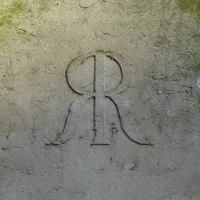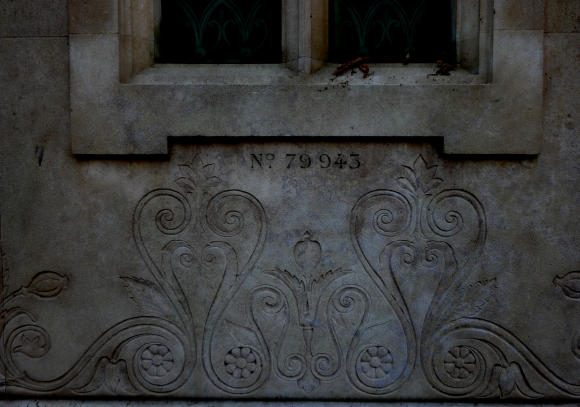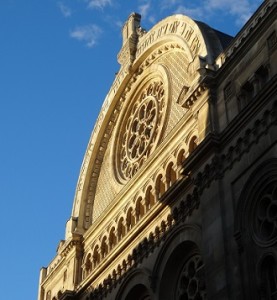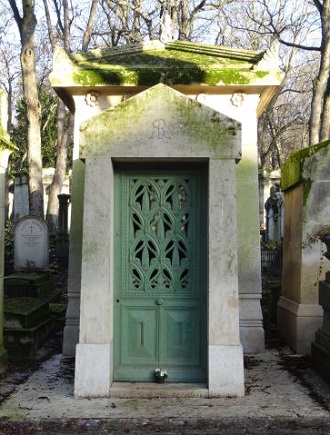
Rothschild: whether pronounced in English, German, Italian or English, the name has for 200 years signified wealth, in particular Jewish wealth. We still speak, as do the French, of someone as being rich as Rothschild (or more likely not rich as Rothschild), and though less common it’s still possible to say upon visiting someone’s home decorated with an abundant in-your-face sense of luxury that its owner has le goût Rothschild, the Rothschild taste.
The French are particularly familiar with the significance of the name thanks to the success of the branch of the Rothschild family that made its mark in high finance in Paris in the 19th century. The French branch of the Rothschild family derives its wealth and reputation from James Rothschild (1792-1868), eventually ennobled to James de Rothschild, who moved to Paris to set up shop in the family finance business at the age of 20.
The name Rothschild itself comes from the roten Schild, the red shield that hung on their home in the Jewish quarter in Frankfurt in the 18th century. James, originally called Jacob, was the youngest of the 10 children of Mayer Amschel Rothschild (1733-1812), founder of the fortuned dynasty whose branches would spread throughout Europe as James and his four brothers, corresponding with each other in Frankfurter Yiddish, established and developed their banking and commercial acumen in Frankfurt, London, Vienna, Naples and Paris. The arms of the family, to whom Francis I, Emperor of Austria, granted the title of baron in 1822, feature a firm hand grasping five arrows and the device Concordia, Integritas, Industria (Unity, Integrity, Activity/Industry)—a clear expression of the Rothschild philosophy of unity in business and in family.
Furthering that unity, James, in 1834, married his 19-year-old niece Betty, the daughter of his Vienna-based brother Salomon von Rothschild. James and Betty’s daughter Charlotte would eventually marry her cousin Nathaniel, son of James’s London-based brother Nathan, creating a closely related an offshoot branch of the Rothschilds in France.

The Pereires and the Camondos
The full emancipation of Jews in Europe, first in France in 1791 and then one by one to most European countries through the 19th century, coincided with the development of banking and industry, enabling several Jewish families to take full part in the rush to wealth of their era and to transmit their fortunes to succeeding generations.
Two other families in haute finance business in Paris in the 19th century were the Pereires and the Camondos. Like James de Rothschild, these families were players in high society and artistic life, creating magnificent homes and art collections. The two families were also of Jewish origin, though the Pereires, originally from Portugal, converted to Christianity once established in France.
The Pereire brothers, Isaac and Emile, born in Bordeaux, made their fortune in finance, railways and real estate. They were major players Haussman’s transformation of Paris and they spearheaded the creation of the Atlantic resort of Arcachon. James de Rothschild and the Pereire brothers joined forces in developing the Paris-Lyon-Méditerranée railway company, and the former quickly became the line’s major shareholder.
The Pereire-Rothschild rivalry in the upper reaches of French finance could also be seen outside of the boardroom as Rothschild built his Chateau de Ferrières just two miles from the Pereires’ Château d’Armainvilliers, in the Brie region just east of Paris. And whereas the Pereires owned the Medoc vineyard of Chateau Palmer (Margaux), James grabbed a piece Médoc by purchasing the first-growth vineyard of Chateau Lafite (Pauillac). James’s son-in-law/nephew Nathaniel was already owner of Chateau (Brane-)Mouton.
Keeping up with the Rothschilds was no easy matter, especially with the brothers and succeeding generations forming an intimate multinational on their own. When the Pereires’ Crédit Mobilier bank went bankrupt in 1867, no one could save their loss of stature in the world of finance.
The Camondo family, a Sephardic Jewish banking family known as “the Rothschilds of the east,” arrived in France after having established their fortune in the Ottoman Empire and then using it to help finance Italian unification. Brothers Abraham (1829-1889) and Nissim (1830-1889) de Camondo, ennobled by King Victor Emmanuel II of Italy for that help, established their residence in France in 1869. Their respective sons, Issac (1851-1911) and Moïse (1860-1935), would eventually bequeath their extensive art and decorative collections to French cultural institutions, with Isaac’s collection of Impressionist and post-Impressionist paintings going to the Louvre and Moïse’s home and collection 18th-century decorative arts going to the French institute and still intact in the form of the Nissim de Camondo Museum, overlooking Parc Monceau in Paris.
The Pereires never regained their financial prominence after bankruptcy and the de Camondo line was extinguished with the death of Moïse’s son in WWI and the deportation of his daughter and grandchildren to Auschwitz in WWII. The Rothschilds were fortunate enough to flee France during the war (though the estranged wife of Philippe de Rothschild, owner of Mouton Rothschild, who was arrested and deported to Ravensbruck, where she died) and to regain most of their possessions afterwards, and the Rothschild name has survived as a sign of wealth and wine.
James de Rothschild

For more than half a century, from his arrival in France in 1812 during the final years of Napoleon’s First Empire to his death in 1868 during the waning days of Napoleon III’s Second Empire, James de Rothschild, along and his brothers, particularly Nathan in London, remained close to power and to governments of all ilk. Anchored with vast banking interests, James played a primordial role in the creation of the northern railway company (Compagnie du chemin de fer du Nord) and, in relation with his brothers, invested in coal mining and assorted commercial activities.
His was the kind of success that inevitably inspired novelist in describing characters of wealth. Balzac (a client of the Rothschild bank) in La Maison Nucingen, Stendhal in Lucien Lewen and Zola in L’Argent would each borrow some of his recognizable traits for characters in their novels.
Through his personal skills in finance and his family’s talents and connections as investment bankers, James de Rothschild became one of the wealthiest men in France and well beyond. As his wealth grew so did his interest in collecting art. He started his collection at age 29 by buying La Laitière (The Milkwoman) by Greuze (which his daughter Charlotte eventually bequeathed to the Louvre), along with Dutch and Flemish paintings. Ingres painted his wife’s portrait. Charlotte had Chopin as piano teacher; he dedicated two waltzes to her.
The mysterious “Rothschild taste” took shape with his personal favorites and a surprising mix of artworks from the Middle Ages, the Renaissance and the 18th century, a taste inherited by his children, who would become significant donors to various museums and institutions in Paris. Some of Rothschild’s illuminated manuscripts, autographs and early photographs eventually found a home in the National Library (BnF). Jewish religious objects that he purchased, such as a Torah breastplate of silver, coral, pearls and semi-precious stones, now enrich the Museum of Jewish Art and History.
As to his own philanthropy, he supported health and geriatric services, notably by creating in 1852 the Rothschild Hospital near Picpus Cemetery in Paris’s 12th arrondissement. The Fondation de Rothschild continues to manage health and geriatric services at a variety of institutions in and around Paris.

Rothschild’s primary residence—and the seat of the family bank in Paris—was at 19 rue Laffitte in the 9th arrondissement. He threw lavish dinner parties orchestrated by Antonin Carême (1784-1833), one of the fathers of French haute cuisine and perhaps France’s first celebrity chef, responsible for creating what soon became legendary dishes bearing the name of his employer: soufflé à la, salmon à la and beef à la Rothschild. In 1838 James de Rothschild purchased the Hôtel de Tallyrand, a mansion at the corner of Place de la Concorde. His descendants owned the mansion until 1950 (during the German occupation it had been requisitioned as headquarters for the German navy), when they sold it to the United States government, which used it to administer the Marshall Plan. The U.S. still owns the property.
Travelers to the Riviera encounter the Rothschild name when visiting the exquisite Villa Ephrussi de Rothschild and its lush gardens overlooking the Mediterranean from Saint-Jean-Cap-Ferrat, just east of Nice. The villa belonged to Béatrice de Rothschild (1864-1934), James’s granddaughter, who had a marriage of great fortune with Maurice Ephrussi, heir to another Jewish banking family. Enough with the Jewish geography!
The most frequent sighting of the Rothschild name these days may well be in reference to wine. Along with other vineyards purchased over time, Lafite Rothschild and Mouton Rothschild still belong to French branches of the Rothschild family. The former is in the hands of Eric de Rothschild, who is also the current president of the Memorial of the Shoah in Paris and the honorary president of the Grande Synagogue de Paris (Rue de la Victoire), which was built with Rothschild family financial support in 1874, six years after James’s death.
James de Rothschild is buried in Paris in the Rothschild family mausoleum in a largely Jewish section (Division 7) of Père Lachaise Cemetery.
© 2013
This article is based on an article by Antoine Prodhomme originally published in French on L’Agora des Arts on the occasion of an exhibition about the Rothschilds in France in the 19th century at the French National Library (BNF – Richelieu) from November 2012 to February 2013. Gary Lee Kraut then translated, modified and expanded that article, with permission, for publication on France Revisited. A video presentation of the BNF exhibition can be viewed here.


very interesting
Shalom, Bonjour.
Fascinating Jewish and family history. I’d like to visit the Grande Synagogue on my next trip to Paris (March). Do they have tours?
Very interesting.
Just a little correction concerning the de Camondo family.
Moïse died in 1935, not 1925. This is consistent with what I saw at their eponymous museum and with wikipedia (” The museum opened the year after Moïse de Camondo died, in 1935. After the German occupation of France during World War II, his daughter, Béatrice, his son-of-law Léon Reinach and their children, Fanny and Bertrand, deported by the French, died in the Auschwitz concentration camp.”).
Michael,
Thanks for being such an attentive reader. Moïse de Camondo did indeed die in 1935.
Thanks for the correction.
Gary